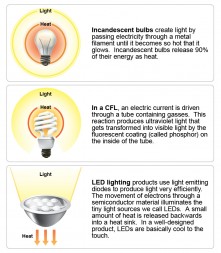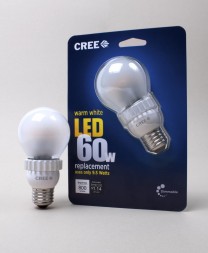Have you heard? Incandescent light bulbs are dead.
Ok, maybe not dead. More like endangered.
The Threat: LED light bulbs.
Have you heard? Incandescent light bulbs are dead.
Ok, maybe not dead. More like endangered.
The Threat: LED light bulbs.
In 2007, the Federal government passed a law mandating a gradual transition to more energy-efficient light bulbs. Manufacturers have already phased out 75 and 100-watt bulbs. And next January will be lights out for the old 40 and 60-watt energy hogs.

Turns out the light bulb Thomas Edison invented over 130 years ago is incredibly inefficient. It’s internal filament wire is basically a heat source that gives off light. Not bad for the 1880s, but considering 17% of the country’s total electricity consumption now goes to lighting our homes and businesses, we have an opportunity to reduce our energy footprint by relying on newer, more efficient options.
While CFLs – those swirly looking, Compact Fluorescent Lights – are certainly more energy-efficient than incandescents, disposing them has always been an issue. CFLs contain mercury, a toxic metal, and must be properly recycled when they burn out. And if they fall and break in your home, well, the EPA has a long list of cleanup precautions, including turning off your central air so the toxins don’t spread.
The real bright spot in the lighting aisle comes from LED bulbs.
These days LEDs can be found everywhere – flashlights, cell phones, street lamps - except the light fixtures in our homes. Why? Because up until now they were simply too expensive for most consumers. But that’s about to change.
 This year Durham, North Carolina-based Cree introduced a $10, 40-watt replacement LED light bulb and a 60-watt replacement model that sells for $13. Both bulbs look and feel like incandescent bulbs, only better.
This year Durham, North Carolina-based Cree introduced a $10, 40-watt replacement LED light bulb and a 60-watt replacement model that sells for $13. Both bulbs look and feel like incandescent bulbs, only better.
Before you write off the LEDs because of the steep price tag, consider this: their 60-watt replacement bulb is designed to last for over 22 years. That’s years. This translates into an estimated annual energy cost of $1.14. By comparison, a standard 60-watt incandescent bulb will burn out in about 11 months and add $7 to your annual energy bill. Consumer Reports crunched the numbers and says you will make your money back with Cree’s 60-watt replacement bulb in under two years; “After that you would save $149 in energy and bulbs over its life when compared with an incandescent.” How many light bulbs do you have in your home? You do the math.
But what about the light quality, you ask? For a long time the knock against CFLs and LEDs was that they simply can’t compete with the warm, bright glow from incandescents. We conducted a little field test to see how the bulbs compare:
http://www.youtube.com/watch?v=8XvLc6VlpI8?feature=player_detailpage
Could you see a difference? From my perspective the light quality was pretty much the same. And I suppose that’s the point.
Bottom line: switching to LED bulbs is a no-brainer if you’re looking to reduce your energy consumption and your utility bill. Most reviewers highlight Cree’s bulbs for its price and light quality. But there are other options on the market, that span the price and light range so shop around and choose an LED bulb that works best for you.